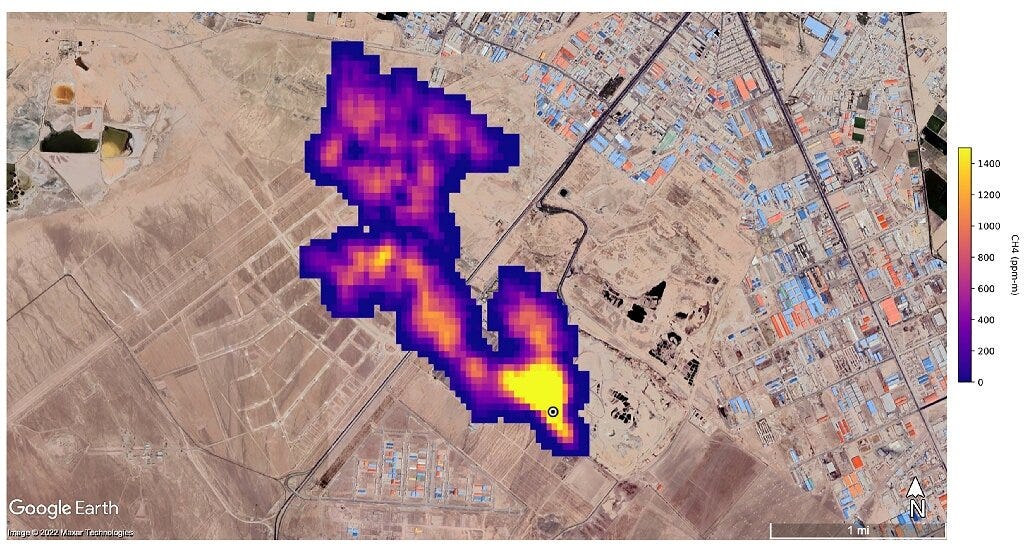Tracking the invisible from space: greenhouse gases
Greenhouse gas emissions are major contributors to global climate change. How can satellites be helpful here? Our overview of the market and existing projects.
Greenhouse gas emissions, mainly carbon dioxide (CO2), methane (CH₄), and nitrous oxide (N₂O), are major contributors to global climate change. Unfortunately, many companies currently measure it as self-reporting according to Excel spreadsheets. We believe that remote sensing will provide a unique opportunity to monitor greenhouse gas emissions on a global and local scale, providing insights into their sources, distribution, and trends, and suggesting effective measures to reduce emissions.
Greenhouse gases (GHG) prevent the Earth's surface from emitting infrared radiation (heat) directly into space. This results in a ~30 degrees warmer planet than it would be without GHG cover. The most powerful GHG is water vapor, but CO2, CH₄, and N₂O also contribute to Earth's equilibrium temperature in a non-obvious way.
Human activity leads to a slight change in the total greenhouse effect. On a planetary scale in 2022, it was about 0.89 degree Celsius hotter than in the 1980s. This is called global warming. It may look small but our civilization has adapted to the specific climate in each region - the way we build houses, plant our crops, consume water, etc. Global warming also leads to extreme weather conditions such as floods, drought, wildfires, permafrost thawing, harvest failures, and other adverse effects. Overall it causes significant losses. For example, the costs of the 2018 wildfires in California were up to $350 billion, or 1.7% of the U.S. GDP. To some estimates, the global economy lost up to US$16 trillion in the past three decades, total. It is almost as much as the GDP of China in 2021 (17.73 trillion USD).
International agreements such as the Paris Climate Accords offer hope that the climate can be kept within limits to avoid the annihilation of the global economy. Among the necessary measures are carbon taxation and offsets, increasing energy efficiency, reducing emissions by 50% by 2030, carbon neutrality by 2050, and GHG capture. This article will focus on sensing GHG from space and companies helping to eliminate emissions using such technologies.
How can satellites be helpful here?
Network sensors on the ground provide accurate GHG concentration measurements at the surface. The sparse coverage of the network is a major limitation: it’s just too costly to cover the planet with gas sensors. Satellite GHG remote sensing is the process of monitoring GHG concentrations by measuring their reflected and emitted radiation from orbit. One of the primary benefits of remote GHG sensing is its ability to provide global coverage. Satellites can measure GHG concentrations over large areas, including remote and inaccessible regions of the planet. This allows for a more comprehensive understanding of the distribution and behavior of GHG in the Earth's atmosphere. Such data can be used for many purposes including regulation, taxation, climate modeling, and predicting the impacts of climate change. etc.
Climate risk is becoming a financial risk, therefore investors are rethinking their strategies to account for climate change, as a core component of ESG. This sets companies-emitters to take seriously GHG accounting of their facilities or carbon offset projects they use. GHG satellite data is becoming part of financial reporting because of companies’, investors’, and employees' demands, not because of regulatory requirements.

There are over 34 GHG remote sensing missions (of which 18 are in orbit and operational, and the rest are in development), and most are driven by public entities.
Space-based measurements can also be used to understand the global carbon cycle, i. e. to monitor the movement of carbon as it is recycled throughout the biosphere and absorbed by carbon sinks like forests and oceans. Understanding carbon sinks is crucial for the sequestration of forests and developing effective climate change mitigation strategies. Apart from sustainability applications, satellite GHG data are used by the financial sector as indicators of economic activity.
Satellite data are used to monitor GHG emissions from specific sources, such as power plants and industrial facilities. This information can be used to identify emission hotspots and leaks and track their changes in emissions over time. Detecting some emissions, like natural gas leaks eliminates direct losses of extracted resources.

National GHG satellite monitoring projects
The first GHG sensing satellite was likely NOAA-10 launched by the USA in 1986. It was capable of day and night observation of global cloud cover, and measurement of atmospheric water and lateral temperature distribution.
Satellite measurements of the column-averaged CO2 fraction became possible in 2002 with the launch of the ESA’s SCIAMACHY infrared spectral instrument aboard ENVISAT. SCIAMACHY operated until 2012 and has been continued by the Japanese GOSAT (2009) and NASA’s Orbiting Carbon Observatory-2 (OCO-2, 2014). Measurements, derived from GOSAT and OCO-2 data, and successive missions of GOSAT-2, and OCO-3, have now reached sufficient accuracy to create detailed maps of CO2 concentrations around the world, revealing hotspots of emissions from sources such as power plants and cities.
China and India play an important role in the global carbon balance and increased carbon sequestration thanks to large-scale reforestation projects. No surprise that these two largest countries have their own GHG monitoring programs, Chinese TanSat and Indian Remote Sensing (IRS).

The ESA's Sentinel-5 Precursor (2017) brings remote sensing to an entirely new level. With the Tropomi spectrometer sensing ultraviolet, visible, near, and short-wavelength infrared it is capable of monitoring additional gases as O₃, CH₄, formaldehyde, aerosol, CO, NO₂, and SO₂ in the atmosphere. This satellite showed substantial reductions in nitrogen dioxide amounts in Chinese cities at the beginning of the COVID-19 pandemic.
The main advantage of this and following Sentinel missions is the public availability of Earth observation data via services like Copernicus Atmosphere Monitoring Service (CAMS). CAMS is one of the six services that are part of the Copernicus program which is managed and coordinated by the European Commission, ESA, and EU Member States.
Existing satellites have already made invaluable contributions to climate modeling and have prompted many countries to change their policies. Data from these satellites allows non-profit organizations to locate key emissions hotspots. With such free publicly available systems, and several upcoming missions, what is left for the private sector?
Democratization of remote sensing
As part of the evolution of GHG remote sensing, the private sector has taken on an increasingly important role, particularly focusing on point-source monitoring of specific gases by identifying emission sources. A special focus is on methane leaks, as this gas is responsible for up to 30% of global warming. Despite its low concentration in the atmosphere, methane has 84 times more warming power than CO2. At the same time, methane leaks are easy to detect and eliminate.

There are 8 commercial projects (single missions or constellations), of which 3 are in orbit and operational, 5 in development, and 5 hybrid missions (all in development). They provide faster, often on-demand access to the emission data of a desired hotspot, with higher spatial resolution than public missions. They often integrate satellite imagery, geolocation data, textual information, and other unconventional data with machine learning, image processing, and advanced mathematics, to measure natural GHG fluxes and industrial activity worldwide.
There are numerous opportunities for startups to leverage AI and software to analyze satellite data and integrate it with ground or drone measurements. In one of our upcoming posts, we'll delve deeper into this topic and explore private GHG sensing satellite constellations. If you're interested in contributing, please don't hesitate to reach out to us.
Our hope is that through the launch of new hybrid and private missions, as well as the provision of free public services, the carbon management market will become more open and transparent. Top accelerators are increasingly focused on investing in climate tech startups. Y Combinator, for instance, has made a significant bet on carbon removal technology. It's worth noting that they are currently accepting applications for their summer 2023 program until April 7th. If you are a SpaceTech startup interested in applying, please reach out to alexandra@spaceambition.org. Our team at Space Ambition has a proven track record of reviewing applications for Y Combinator.
As always, if you're interested in gaining access to the full research behind this article, please reach out to us.







Thanks for your article. Are there any startups that launch constellations to monitor GHG?
Do you know what's missing here - the types of sensors you need for this kind of monitoring. Without it you can't get the full picture.